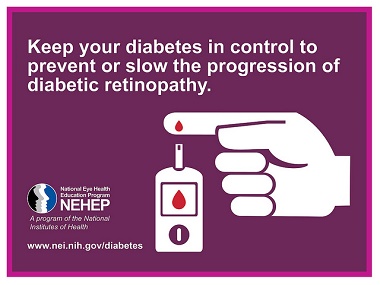Editor’s note: One of the many benefits associated with an online information center and website, such as VisionAware, is the ability to track readers’ search terms [i.e., information readers are seeking as they search the Internet].
Since the earliest days of VisionAware.org, questions about diabetes have consistently ranked high within the top information searches. Peer Advisor and diabetes educator Audrey Demmitt, R.N., provides this helpful two-part series on what readers want to know about managing medications.

Since November is Diabetes Awareness Month, we are highlighting diabetes as it is a major cause of vision problems. According to the National Eye Institute, about 45 percent of people with diabetes have some evidence of diabetic retinopathy in various stages, causing visual changes ranging from temporary blurred vision to permanent blindness. And as you can imagine, medication management becomes very challenging with vision loss. VisionAware has many resources to help you with medication management as noted in this post.

Medications Used to Treat Diabetes
There is a variety of medications used to treat diabetes. Some people use only pills while others use insulin from vials, preloaded injection pens or programmable pumps. Still others may use a combination of oral drugs, insulin and other injectable drugs. No matter what, it is important to come up with a system to ensure you are taking the right medication, at the right time, in the right dose, and in the right way. It is critical to be able to take your medications safely and correctly in order to avoid dangerously low or high blood sugars. Taking your medications properly also helps avoid the complication of vision loss from diabetic retinopathy.
Here are some tips to help you confidently manage your medication regimen if you are experiencing vision loss:
- Get a low vision exam. The low vision eye care specialist is trained to conduct a functional eye examination that focuses directly on how a person’s particular vision impairment affects his or her day-to-day living. He or she will prescribe low vision devices such as magnifiers or electronic aids that will help you managing your medications. A low vision therapist. A low vision therapist will teach you about devices and lighting which can maximize your useable vision.
- Check into obtaining vision rehabilitation services. Vision rehabilitation therapists can teach you about adaptive equipment and special techniques to manage medications. Check out the VisionAware directory to find services near you.
- Talk to your healthcare team about your visual changes. Be sure they are aware of the challenges you are having with your diabetes self- care. Ask your doctor for information that you can access with your level of vision. Request classes from a diabetes educator who can work with you to personalize your medication routines and help you problem-solve. You may want to check out VisionAware’s Diabetes Guides to get you started. These are available in English and en espanol.
- Talk to your pharmacist. Be sure you understand what types of medications you are on including how they work, how to take them and how to store them. Request large print instructions and labels on medicine bottles and explore talking prescription bottle programs. Many pharmacies, including most of the major drug stores and the Veterans Administration, offer devices with “audio” instructions and even alarms to remind you when to take your medicines. Your pharmacist is a great resource for information on your medicines and diabetes supplies.
- Mark your medicine bottles. Use bold and high contrast markers to label bottles, vials, and other supplies. Rewrite the instructions and expiration dates on a card and attach to the original container. Hand held magnifiers can help with reading labels, expiration dates and instructions. Colored tape, rubber bands, fabric paint and tactile bump dots can be useful to distinguish between long-acting insulin and regular insulin vials or morning meds and bedtime meds. Be creative and discuss ideas on ways to organize and label medicines and supplies with your vision rehabilitation therapist to develop a system that works for you.
- Consider using an insulin pen instead of syringes. Preloaded insulin pens may be easier to use than a syringe and vial which requires drawing up each dose. Pens have fewer steps to use and audible “clicks” that can be counted when the dial is turned to set the proper dose which helps prevent errors. Changing the pen needle is recommended after each injection. To help you remember if you took your daily dose from your pen, use a days-of-the week pill organizer. Fill each slot with an unused pen needle at the start of the week. Use the needle for that day’s injection. When you are not sure if you took your shot, check the day’s box. If there’s a needle, you haven’t taken your insulin yet.
Part 2 in this series will cover adaptive products that make medication management easier.